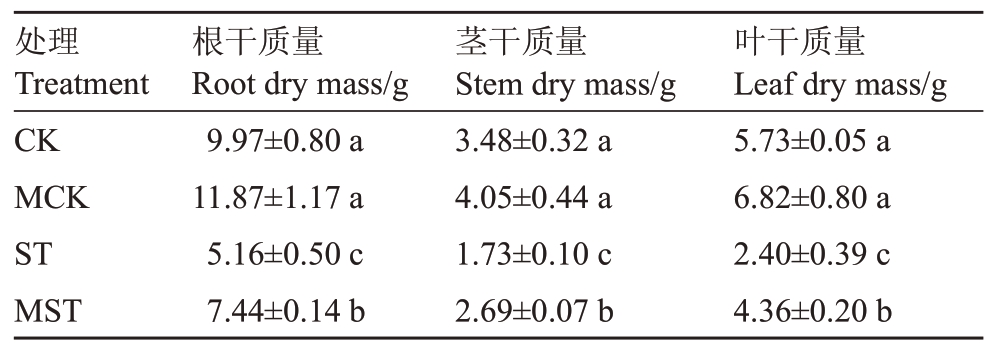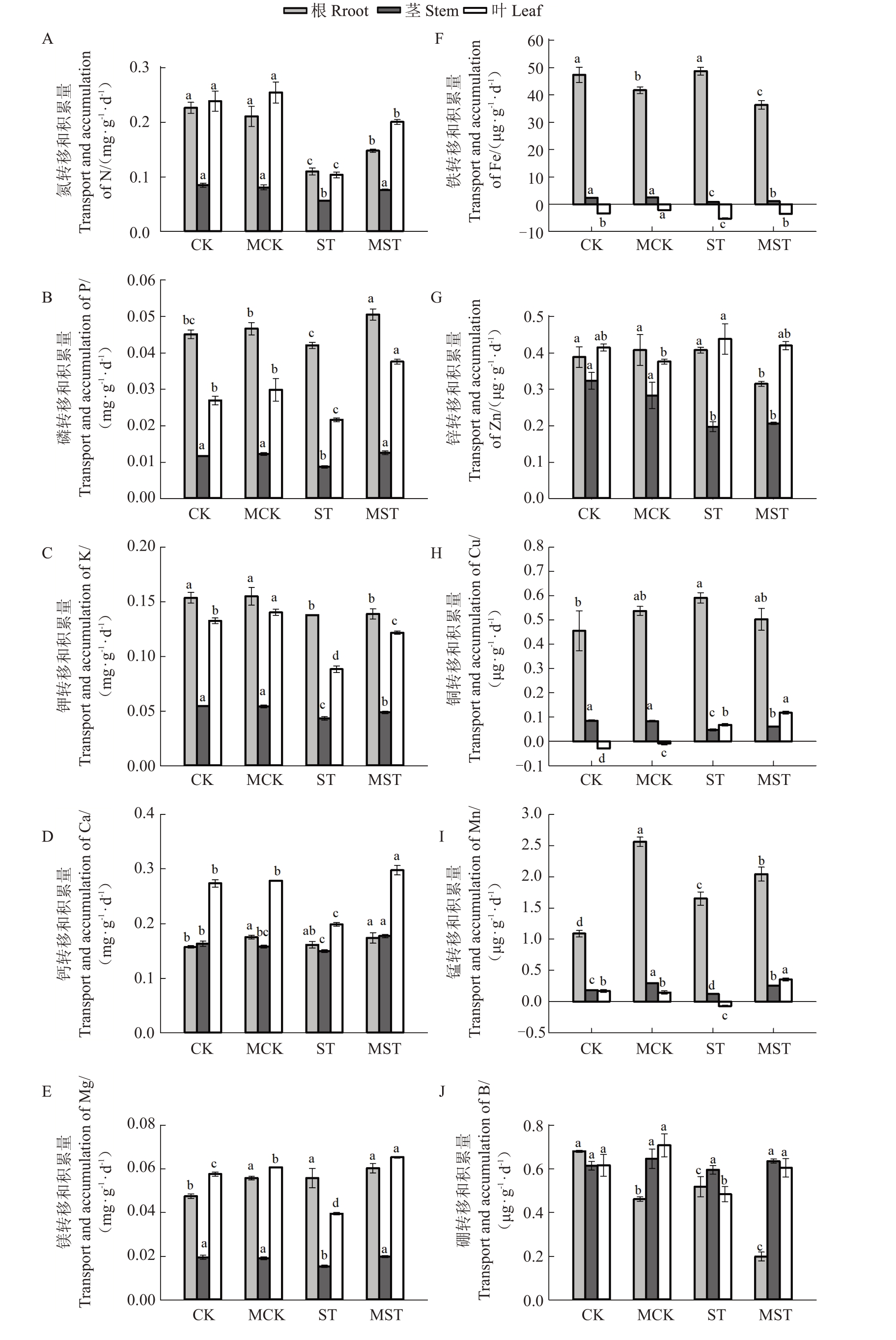苹果是世界四大主栽果树之一。目前,我国苹果栽培面积、总产量与出口量均占世界第一,已成为世界上最大的苹果生产和消费国[1]。然而,中国大多数主要产区的果树已经超过使用寿命,进入衰老阶段,目前约有70%的果园树龄超过20 a(年)[2]。受土地资源和栽培条件的限制,同样的土地通常被用于重复生产,在这种情况下,苹果再植病(apple replant disease,ARD)已经变得非常普遍[2]。ARD 是一种通过土壤传播的疾病,ARD的复杂症状降低了苹果的生长和生产力。再植后的苹果树木生长减慢,叶片变黄,节间明显缩短,根部变色,根尖坏死,根系生物量下降,最终导致植株死亡[3]。因此,重茬障碍也成了苹果种植产业健康发展亟待解决的难题。
褪黑素(melatonin)是一种高度保守的吲哚类化合物,从牛松果体中首次分离得到[4]。作为一种新型的植物生长调节剂,褪黑素不仅参与提高种子发芽率[5]、调节开花[6]和延缓衰老[7]等多种发育和生理过程;还可以调节矿质元素的吸收和分配,进而增强植株对各种逆境胁迫的耐受性[8]。目前,防治各种重茬障碍的应用研究主要关注根际土壤理化性质、代谢物质和微生物群落结构的改变[9-11],以及对土壤微域环境和植株性能的影响等方面,有关植株对矿质养分吸收的报道较少,尤其是外源褪黑素对重茬胁迫下植株生长与养分利用关系的相关研究还较为缺乏。近年来,有研究发现外源褪黑素能够通过提高土壤酶活性、改变微生物群落结构来改善土壤环境,进而促进苹果植株的生长[12]。然而能否通过施用外源褪黑素来促进重茬胁迫下植株养分的吸收与利用还值得进一步研究。因此,笔者在本研究中以平邑甜茶实生苗为试材,探究外源褪黑素对重茬胁迫下平邑甜茶幼苗矿质元素氮(N)、磷(P)、钾(K)、钙(Ca)、镁(Mg)、铁(Fe)、锌(Zn)、铜(Cu)、锰(Mn)和硼(B)吸收利用的影响。利用不同处理间矿质养分利用的差异和植株生长的关系,阐明外源褪黑素对苹果重茬障碍的调控机制,也为苹果重茬障碍的防治提供理论依据和技术支持。
1 材料和方法
1.1 试验设计
本试验于河北农业大学创新试验园(38°230'N,115°280' E)进行。重茬土取自河北省保定市30 a(年)的老果园,健康土壤取自邻近老果园周围的麦田土,从地表移除树叶和其他松散物质后,从多个随机选择的地点收集土壤,深度为5~40 cm,使用前将土壤混匀并过6 mm筛。
试验材料为平邑甜茶(Malus hupenensis Rehd.)实生苗。无融合生殖型平邑甜茶种子来自于山东平邑(35°70'N,117°250'E)。首先将种子充分浸湿后与细沙混匀,然后在4 ℃的条件下低温层积处理50 d,种子萌发后,在每个装有基质的营养钵中播种4 粒种子并将其置于具有自然光照和温度条件下的温室中培养。当幼苗长到6~8 枚真叶时,将其转移到高17.6 cm、上口径26.5 cm、底径23 cm 的塑料透气花盆中。
研究中褪黑素的浓度与文献[12]一致。在充足的水分和光照条件下生长30 d 后,400 株健康一致的平邑甜茶幼苗被平均分为4组:正常对照,植株生长在健康土壤中(CK);褪黑素对照,植株生长在添加200 μmol·L-1褪黑素的健康土壤中(MCK);重茬胁迫处理:植株生长在重茬土壤中(ST);重茬胁迫处理+褪黑素,植株生长在添加200 μmol·L-1褪黑素的重茬土壤中(MST)。从2021年6—10月,每7 d进行1次褪黑素处理,共处理120 d。
1.2 测定指标及方法
1.2.1 生长指标的测定 干质量的测定:在试验结束之前,从每个处理中收获整株植物,并将其分为根、茎和叶部分。所有植物样品在自来水、蒸馏水和超纯水中洗涤擦干后于105 ℃杀青30 min,65 ℃烘干至恒质量;然后用分析天平称量各部分干质量。
1.2.2 矿质元素浓度的测定 将植株根、茎和叶的各部分干样磨碎混匀,过1 mm 筛,采用H2SO4-H2O2和HNO3-H2O2消解法,全量N、P 元素浓度用连续流动分析仪(AA3; SEAL Analytical, Norderstedt, Germany)测定;全量K、Ca、Mg、Fe、Zn、Cu、Mn、B 等元素含量用电感耦合等离子体质谱(iCAP Q ICP-MS;Thermo Fisher Scientific,Waltham,MA,USA)测定。
1.2.3 矿质元素吸收、转移(积累)和分配量的测定 矿质元素吸收量、转移量和分配量根据梁博文等[13]的公式计算。
矿质元素吸收量:植株根、茎和叶各部分的干质量×对应组织的元素浓度×相对生长速率(relative growth rate,RGR)。
矿质元素转移(积累)量:(M120-M0)×(lnW120-lnW0)/(W120-W0)/(T120-T0)。其中M代表植株体内各元素总含量,W代表根干质量,T代表处理时间。
矿质元素分配量:植株根、茎、叶各部分的干质量×对应组织的元素含量。
2 结果与分析
2.1 重茬胁迫下外源褪黑素对植株生长的影响
从表1中看出,与对照相比,ST处理下平邑甜茶幼苗根、茎、叶各部分的干质量均显著降低,分别下降了48.24%、50.29%和58.12%;与ST 相比,MST 处理下平邑甜茶幼苗各部分的干质量均显著升高,分别升高了44.19%、67.63%和81.67%。
表1 重茬胁迫下外源褪黑素处理120 d 对平邑甜茶幼苗生长的影响
Table 1 Effects of exogenous melatonin treatment for 120 days on the growth of M.hupehensis seedlings under replant stress

注:数据由平均值±标准差组成,3 次重复,同行不同小写字母表示存在显著差异(p<0.05)。CK 表示植物生长在健康土壤中;MCK 表示植株生长在添加200 μmol·L-1 褪黑素的健康土壤中;ST 表示植株生长在重茬土壤中;MST 表示植株生长在添加200 μmol·L-1褪黑素的重茬土壤中。下同。
Note: Data are means ± standard deviation (n=3). Bars not labeled with same letter indicate significant differences at p<0.05, based on Tukey’s multiple range tests. CK, plants grown with control soil;MCK, plants grown in control soil with 200 μmol·L-1 melatonin; ST,plants grown in replant soil; MST, plants grown in replant soil with 200 μmol·L-1 melatonin.The same below.
?
2.2 重茬胁迫下外源褪黑素对植株矿质元素浓度的影响
试验处理120 d后,测定并分析了植株根、茎、叶各部分矿质元素含量。如表2所示,与对照相比,重茬胁迫显著降低了根中N 和B 的含量,分别降低了42.47%和11.63%;但Ca、Mg、Fe、Zn、Cu 和Mn 的含量显著升高,分别升高了17.85%、33.91%、21.03%、20.52%、47.14%和70.01%;对P 和K 的含量没有显著影响。与重茬胁迫处理植株相比,重茬胁迫下施加外源褪黑素显著升高了根中N、P 和Mn 的含量,分别升高了21.77%、10.26%和13.33%;显著降低了Fe、Zn、Cu 和B 的含量,分别降低了30.91%、28.58%、21.70%和63.84%;但对K、Ca 和Mg 的含量无显著影响。
表2 重茬胁迫下外源褪黑素处理120 d 对平邑甜茶幼苗根中矿质元素浓度的影响
Table 2 Effects of exogenous melatonin treatment for 120 days on concentration of nutritional elements in roots of M.hupehensis seedlings under replant stress

?
如表3 所示,重茬胁迫同时能够影响茎中矿质元素的含量,显著降低了茎中N、Fe和Zn的含量,分别降低了15.64%、21.01%和23.47%;并显著升高了Ca 和B 的含量,分别升高了10.23%和17.18%;但对P、K、Mg、Cu 和Mn 含量没有显著影响。与重茬胁迫处理植株相比,重茬胁迫下施加外源褪黑素显著升高了茎中N、P和Mn的含量,分别升高了11.83%、9.38%和42.29%;显著降低了茎中K、Fe 和B 的含量,分别降低了4.08%、15.73%和8.96%,但对Ca、Mg、Zn和Cu含量没有显著影响。
表3 重茬胁迫下外源褪黑素处理120 d 对平邑甜茶幼苗茎中矿质元素浓度的影响
Table 3 Effects of exogenous melatonin treatment for 120 days on concentration of nutritional elements in stem of M.hupehensis seedlings under replant stress

?
重茬胁迫还改变了叶中矿质元素的含量,如表4所示,与生长在健康土壤中的植株相比,重茬胁迫显著降低了叶中N的含量(27.71%);但P、Ca、Fe、Zn和Cu的含量显著升高,分别升高了20.34%、5.58%、73.55%、53.64%和1.74%;对K、Mg、Mn 和B 的含量无显著影响。与重茬胁迫处理植株相比,重茬胁迫下施加外源褪黑素显著升高了叶中N、P、Ca、Mg 和Mn 的含量,分别升高了25.43%、20.42%、7.64%、17.67%和11.80%;显著降低了Fe、Zn、Cu的含量,分别降低了37.95%、30.32%和18.62%;但对K 和B 的含量无显著影响。
表4 重茬胁迫下外源褪黑素处理120 d 对平邑甜茶幼苗叶片中矿质元素浓度的影响
Table 4 Effects of exogenous melatonin treatment for 120 days on concentration of nutritional elements in leaves of M.hupehensis seedlings under replant stress

?
2.3 重茬胁迫下外源褪黑素对平邑甜茶幼苗矿质元素吸收的影响
如图1-A~E 所示,与生长在健康土壤中的植株相比,重茬胁迫显著降低了植株对大量元素N、P、K、Ca 和Mg 元素的吸收,其分别降低了74.04%、56.46%、61.17%、57.96%和56.50%。但施加外源褪黑素能够显著缓解这种抑制作用,重茬胁迫下施加外源褪黑素植株的吸收量只分别降低了41.61%、11.13%、32.83%、19.50%和14.20%。重茬胁迫同时也显著抑制了植株对微量元素的吸收(图1-F~J)。与对照植株相比,重茬胁迫对微量元素Fe、Zn、Cu、Mn 和B 的吸收量分别降低了49.49%、54.28%、37.57%、46.05%和58.91%。但在重茬胁迫下施加外源褪黑素能够显著促进植株对其的吸收,与ST植株相比,MST 植株的吸收量分别升高了16.15%、36.21%、40.47%、101.09%和36.07%。

图1 重茬胁迫下外源褪黑素处理120 d 对平邑甜茶幼苗矿质元素吸收的影响
Fig.1 Effects of exogenous melatonin treatment for 120 days on uptake fluxes of nutritional element in M.hupehensis seedlings under replant stress
数据由平均值±标准差组成,3 次重复,不同小写字母表示存在显著差异(p<0.05)。CK 表示植物生长在健康土壤中;MCK 表示植株生长在添加200 μmol·L-1 褪黑素的健康土壤中;ST 表示植株生长在重茬土壤中;MST 表示植株生长在添加200 μmol·L-1 褪黑素的重茬土壤中。下同。
Data are means±standard deviation(n=3).Within a row,values not followed by the same letters indicate significant differences at p<0.05,based on Tukey’s multiple range tests. CK, plants grown with control soil; MCK, plants grown in control soil with 200 μmol·L-1 melatonin; ST, plants grown in replant soil;MST,plants grown in replant soil with 200 μmol·L-1 melatonin.The same below.
2.4 重茬胁迫下外源褪黑素对平邑甜茶幼苗矿质元素转移和积累的影响
如图2 所示,重茬胁迫处理显著影响了大量元素和微量元素在根中的积累量,与生长在健康土壤中的植株相比,重茬胁迫植株根中Mg、Fe、Zn、Cu和Mn的积累量分别升高了17.38%、2.87%、4.95%、29.86%和51.64%,但N、K和B的积累量分别显著降低了51.46%、10.29%和23.84%。重茬胁迫下施加外源褪黑素能够显著提高根中N、P 和Mn 的积累量,分别升高了34.52%、20.03%和23.73%,并显著降低了Fe、Zn 和B 的积累量,分别下降了25.34%、22.72%和61.62%。另外,重茬胁迫还影响了矿质元素向叶片和茎中转移的速率,除B和Zn元素外,N、P、K、Ca、Mg、Fe、Zn和Cu向叶片和茎中转移的速率均显著降低。此外,与在重茬土壤中生长的植株相比,外源施加褪黑素也影响了上述元素向叶片和茎中转移的速率,除B 和Zn 元素无显著影响外,其余元素向叶片和茎中转移的速率均显著升高。

图2 重茬胁迫下外源褪黑素处理120 d 对植株矿质元素转移和积累的影响
Fig.2 Effects of exogenous melatonin treatment for 120 days on nutritional element translocation and accumulation in plants under replant stress
2.5 重茬胁迫下外源褪黑素对平邑甜茶幼苗矿质元素分配的影响
处理120 d后,矿质元素在根、茎、叶中的分配各不相同,其中P、K、Fe、Cu和Mn的含量在根中最高,N、Ca、Mg 和Zn 的含量在叶中最多,而B 在茎中的分布最多(图3)。如图3所示,重茬胁迫处理后所有测定元素在根茎叶的比例均显著降低,与正常对照植株相比,ST 植株根、茎、叶中N、P、K、Ca、Mg、Fe、Zn、Cu、Mn 和B 的含量分别下降了70.3%、58.17%、69.73%,44.45%、47.96%、49.58%,46.65%、52.08%、59.12%,39.09%、45.26%、55.74%,30.45%、52.42%、57.87%,37.44%、60.77%、27.27%,37.69%、61.99%、35.62%,23.52%、58.20%、14.96%,12.11%,53.21%、60.09%和54.31%、41.8%、52.26%。此外重茬胁迫下外源施加200 μmol·L-1褪黑素能够增加几乎所有研究元素在根茎叶中分布的比例。与生长在重茬土壤中的植株相比,MST 植株根中N、P、K、Ca、Mg、Zn、Cu、Mn的含量分别提高了76.13%、59.62%、34.30%、43.43%、44.21%、3.17%、13.11%和63.63%,茎中N、P、K、Ca、Mg、Fe、Zn、Cu、Mn、B 的含量分别提高了73.78%、69.29%、48.74%、57.21%、69.46%、30.86%、36.49%、45.81%、121.08%和41.42%,叶片中N、P、K、Ca、Mg、Fe、Zn、Cu、Mn、B 的含量分别提高了128.15% 、119.16% 、79.73% 、95.63% 、113.28% 、12.81%、26.70%、47.85%、103.23%和62.08%。

图3 不同处理条件下平邑甜茶幼苗矿质元素在根茎叶中的累积和分配
Fig.3 Concentrations and partitioning of nutritional element in roots,stems,and leaves of M.hupehensis plants under different treatment conditions
2.6 重茬胁迫下平邑甜茶幼苗矿质元素含量与生长的相关性分析
为了探讨外源褪黑素处理后苹果植株中各矿质元素含量与生长存在的相关性,对平邑甜茶植株体内10种矿质元素含量与各部分干质量进行了Mantel检验和Pearson相关性分析,结果如图4所示。处理120 d,平邑甜茶植株中各矿质元素与各部分干质量均呈正相关,此外各矿质元素间也呈正相关。其中,N 含量与K、Ca、Mg、Zn 和B 元素含量呈显著正相关;P 含量与Ca 和Mg 元素含量呈显著正相关;K含量与Ca、Mg、Zn 和B 元素含量呈显著正相关;Ca含量与Mg 元素含量呈显著正相关;Mg 含量与Cu元素含量呈显著正相关;Fe含量与Zn元素含量呈显著正相关;Zn 含量与B 元素含量呈显著正相关;Cu含量与Mn元素含量呈显著正相关。此外Mantel 检验显示植株各部分干质量与N、P、K、Ca、Mg、Zn 和B元素含量呈显著正相关,而与Fe、Cu和Mn元素含量无显著相关性。

图4 平邑甜茶植株中各部分矿质元素与生长的相关性组合热图
Fig.4 Combined heatmap of correlation between mineral elements and growth of variousparts of M.hupehensis plants
3 讨 论
重茬胁迫又被称为连作障碍、再植病,是由于在同一块土地上连续栽培同种或近缘作物时,即使在正常的栽培管理模式下,也会表现出产量降低、品质变劣、生长状况变差、病虫害加重的一种现象[14-16]。随着人口的增加和经济的飞速发展,这一问题已成为制约农业可持续发展的重要因素。重茬胁迫成因复杂且危害严重。再植障碍发生时,轻者会影响作物产量和品质,严重时甚至导致绝产,给农民造成巨大的经济损失。随着土地资源日趋紧张,重茬障碍现象日愈严重,已成为国内外学者研究的热点问题。王芳等[17]的研究结果表明,连作障碍严重抑制茄子幼苗生长,播种后45 d 内重茬处理茄子幼苗的株高、侧根数、叶片展开数、主根长和总根长均受到严重抑制。吕卫光等[18]研究发现盆栽黄瓜连作对其生长发育具有明显的影响,连作后的黄瓜生长减慢,植株矮小,干物质含量降低。康亚龙等[19]也证明了加工番茄连作7 a后果实减少,果实品质和产量显著降低。本研究表明,重茬胁迫严重抑制苹果植株的生长,重茬处理120 d 后,苹果植株的各部分干质量显著降低。这一结果与田给林[20]、董晓民等[21]在其他果树上的研究结果一致。
褪黑素在植物体内的首要功能是作为第一道防线来抵御内部和外部环境产生的氧化胁迫[22]。褪黑素可通过直接清除活性氧自由基和上调表达抗氧化酶基因来行使这一功能。由于褪黑素的这些特性,它经常被用来抵御各种外界胁迫,例如重金属胁迫[23]和盐胁迫[24]。虽然外源施加褪黑素能够促进植物生长发育[25-26],但没有研究报道褪黑素是如何通过调控植物养分吸收来行使功能的。本试验结果表明,重茬胁迫能够抑制苹果植株正常生长,但外源施加褪黑素能够显著缓解这些抑制作用,本研究首次报道了重茬胁迫下褪黑素对苹果植株养分吸收和植株生长的影响。
矿质营养是苹果生长发育、产量形成和品质提高的物质基础[27-28]。良好的营养状况可以促进苹果树体生长健壮,器官建造良好,质膜生物活性高,代谢活动旺盛,这不仅成为苹果高产、稳产、优质的基础,而且还增强了苹果抗御外界不良条件即逆境胁迫的能力[13]。重茬胁迫下植株由于根系受阻导致根吸收动力下降,进而抑制了根系对营养元素的吸收与运输[29]。充足的养分吸收对维持植物结构完整性和行使正常生理功能起重要的作用,任何养分的吸收发生变化都会对植物代谢产生不利影响[30]。褪黑素对植物体内矿质元素组成和通过上调元素含量来缓解胁迫有至关重要的调控作用。本研究中,与生长在健康土壤中的植株相比,重茬胁迫显著抑制了植株对大量元素和微量元素的吸收,并降低了所测元素在根茎叶中的比例,施加外源褪黑素能够显著缓解这种抑制作用。此外,褪黑素在其他胁迫条件下也能促进植株对养分的吸收。梁博文等[13]研究发现干旱胁迫下外源施加100 μmol·L-1 褪黑素能够显著缓解苹果植株体内大量元素和微量元素含量的降低。曹扬等[31]在养分胁迫的条件下也得出了这一结论。此外Mantel检验结果也表明处理120 d,平邑甜茶植株中各矿质元素含量与各部分干质量之间密切相关且呈正相关。这进一步表明了外源褪黑素通过调节苹果植株体内元素组成和含量来促进植株生长,进而增强苹果植株对重茬胁迫的耐受性。褪黑素作为一种新型的生长调节剂和活性氧清除剂在提高植物养分利用效率等方面发挥着重要作用,但因其生产成本较高及见光易分解等特性,期待新的合成技术等降低其生产成本,有利于其更加广泛地应用于农业生产。
4 结 论
重茬胁迫下外源根施褪黑素显著提高了平邑甜茶植株各部分干质量,促进了各元素在植株体内的吸收和利用,并通过调节平邑甜茶植株体内元素组成和含量来促进植株生长,进而增强植株对重茬胁迫的耐受性。
[1] 陈学森,郝玉金,杨洪强,毛志泉,姜远茂,彭福田,沈向,张继祥,陈晓流,束怀瑞.我国苹果产业优质高效发展的10 项关键技术[J].中国果树,2010(4):65-67.CHEN Xuesen,HAO Yujin,YANG Hongqiang,MAO Zhiquan,JIANG Yuanmao,PENG Futian,SHEN Xiang,ZHANG Jixiang,CHEN Xiaoliu,SHU Huairui. Ten key technologies for highquality and efficient development of apple industry in China[J].China Fruits,2010(4):65-67.
[2] SUN J,ZHANG Q,ZHOU J,WEI Q P. Illumina amplicon sequencing of 16S rRNA tag reveals bacterial community development in the rhizosphere of apple nurseries at a replant disease site and a new planting site[J].PLoS One,2014,9(10):e111744.
[3] MAZZOLA M,MANICI L M.Apple replant disease:role of microbial ecology in cause and control[J].Annual Review of Phytopathology,2012,50:45-65.
[4] LERNER A B,CASE J D,TAKAHASHI Y,LEE T H,MORI W. Isolation of melatonin,the pineal gland factor that lightens melanocytes1[J]. Journal of the American Chemical Society,1958,80(10):2587.
[5] POSMYK M M,KURAN H N,MARCINIAK K,JANAS K M.Presowing seed treatment with melatonin protects red cabbage seedlings against toxic copper ion concentrations[J]. Journal of Pineal Research,2008,45(1):24-31.
[6] KOLÁŘ J,JOHNSON C H,MACHÁČKOVÁ I. Exogenously applied melatonin (N-acetyl-5-methoxytryptamine) affects flowering of the short-day plant Chenopodium rubrum[J]. Physiologia Plantarum,2003,118(4):605-612.
[7] ARNAO M B,HERNÁNDEZ-RUIZ J.Protective effect of melatonin against chlorophyll degradation during the senescence of barley leaves[J].Journal of Pineal Research,2009,46(1):58-63.
[8] LIANG B W,GAO T T,ZHAO Q,MA C Q,CHEN Q,WEI Z W,LI C Y,LI C,MA F W. Effects of exogenous dopamine on the uptake,transport,and resorption of apple ionome under moderate drought[J].Frontiers in Plant Science,2018,9:755.
[9] SHENG Y F,WANG H Y,WANG M,LI H H,XIANG L,PAN F B,CHEN X S,SHEN X,YIN C M,MAO Z Q.Effects of soil texture on the growth of young apple trees and soil microbial community structure under replanted conditions[J]. Horticultural Plant Journal,2020,6(3):123-131.
[10] XIANG L,WANG M,JIANG W T,WANG Y F,CHEN X S,YIN C M,MAO Z Q.Key indicators for renewal and reconstruction of perennial trees soil:Microorganisms and phloridzin[J].Ecotoxicology and Environmental Safety,2021,225:112723.
[11] 杨凡,王建宏,蔡毓新,程俊跃,唐艳领,陈绘利,马凯,米国全,史宣杰.设施黄瓜连作障碍灾变机制及酵素菌应用研究进展[J].中国瓜菜,2022,35(7):6-12.YANG Fan,WANG Jianhong,CAI Yuxin,CHENG Junyue,TANG Yanling,CHEN Huili,MA Kai,MI Guoquan,SHI Xuanjie. Advances of disaster mechanism on cucumber continuous cropping disorder and application of enzyme microorganism[J].China Cucurbits and Vegetables,2022,35(7):6-12.
[12] LI C,ZHAO Q,GAO T T,WANG H Y,ZHANG Z J,LIANG B W,WEI Z W,LIU C H,MA F W.The mitigation effects of exogenous melatonin on replant disease in apple[J]. Journal of Pineal Research,2018,65(4):e12523.
[13] LIANG B W,MA C Q,ZHANG Z J,WEI Z W,GAO T T,ZHAO Q,MA F W,LI C. Long-term exogenous application of melatonin improves nutrient uptake fluxes in apple plants under moderate drought stress[J]. Environmental and Experimental Botany,2018,155:650-661.
[14] 张晓玲,潘振刚,周晓锋,倪吾钟.自毒作用与连作障碍[J].土壤通报,2007,38(4):781-784.ZHANG Xiaoling,PAN Zhengang,ZHOU Xiaofeng,NI Wuzhong. Autotoxicity and continuous cropping obstacles:A review[J].Chinese Journal of Soil Science,2007,38(4):781-784.
[15] 李华玮,赵绪永,李鹏坤.作物连作障碍中酚酸类物质的生物降解研究[J].中国农学通报,2011,27(18):168-173.LI Huawei,ZHAO Xuyong,LI Pengkun. Research on biodegradation effect to phenolic acid in even cook obstacles[J].Chinese Agricultural Science Bulletin,2011,27(18):168-173.
[16] 马二磊,黄芸萍,臧全宇,郝芳敏,丁伟红,王毓洪,高海东,刘磊.4 种微生物菌剂对多年连作甜瓜土壤真菌群落的影响[J].中国瓜菜,2021,34(4):15-20.MA Erlei,HUANG Yunping,ZANG Quanyu,HAO Fangmin,DING Weihong,WANG Yuhong,GAO Haidong,LIU Lei. Effects of four microbial agents on soil fungal community in continuous cropping melon based on diversity sequencing[J]. China Cucurbits and Vegetables,2021,34(4):15-20.
[17] 王芳,王敬国.连作对茄子苗期生长的影响研究[J].中国生态农业学报,2005,13(1):79-81.WANG Fang,WANG Jingguo. Study on the effect of continuous cropping on the growth of eggplant seedlings[J]. Chinese Journal of Eco-Agriculture,2005,13(1):79-81.
[18] 吕卫光,余廷园,诸海涛,沈其荣,张春兰.黄瓜连作对土壤理化性状及生物活性的影响研究[J].中国生态农业学报,2006,14(2):119-121.LÜ Weiguang,YU Tingyuan,ZHU Haitao,SHEN Qirong,ZHANG Chunlan. Effects of cucumber continuous cropping on the soil physi-chemical characters and biological activities[J].Chinese Journal of Eco-Agriculture,2006,14(2):119-121.
[19] 康亚龙,刘彦荣,刘建国,李梦格,郝梦超,蒋桂英.连作对加工番茄植株生理活性和物质生产的影响[J].中国生态农业学报,2015,23(3):319-328.KANG Yalong,LIU Yanrong,LIU Jianguo,LI Mengge,HAO Mengchao,JIANG Guiying. Physiological activity and material production in processing tomato under continuous cropping[J].Chinese Journal of Eco-Agriculture,2015,23(3):319-328.
[20] 田给林.连作草莓土壤酚酸类物质的化感作用及其生物调控研究[D].北京:中国农业大学,2015.TIAN Geilin. Allelopathic effect and biological regulation of phenolic acids in the continuous cropping strawberry soil[D].Beijing:China Agricultural University,2015.
[21] 董晓民,高晓兰,刘伟,李桂祥,李淼,张安宁.桃连作障碍中自毒作用的研究进展[J].黑龙江农业科学,2021(2):123-127.DONG Xiaomin,GAO Xiaolan,LIU Wei,LI Guixiang,LI Miao,ZHANG Anning. Research progress of autotoxicity in continuous cropping obstacle of peach[J]. Heilongjiang Agricultural Sciences,2021(2):123-127.
[22] TAN D X,HARDELAND R,MANCHESTER L C,KORKMAZ A,MA S R,ROSALES-CORRAL S,REITER R J.Functional roles of melatonin in plants,and perspectives in nutritional and agricultural science[J]. Journal of Experimental Botany,2012,63(2):577-597.
[23] KAYA C,OKANT M,UGURLAR F,ALYEMENI M N,ASHRAF M,AHMAD P. Melatonin-mediated nitric oxide improves tolerance to cadmium toxicity by reducing oxidative stress in wheat plants[J].Chemosphere,2019,225:627-638.
[24] LI C,WANG P,WEI Z W,LIANG D,LIU C H,YIN L H,JIA D F,FU M Y,MA F W. The mitigation effects of exogenous melatonin on salinity-induced stress in Malus hupehensis[J].Journal of Pineal Research,2012,53(3):298-306.
[25] PARK S,BACK K.Melatonin promotes seminal root elongation and root growth in transgenic rice after germination[J]. Journal of Pineal Research,2012,53(4):385-389.
[26] WEI W,LI Q T,CHU Y N,REITER R J,YU X M,ZHU D H,ZHANG W K,MA B,LIN Q,ZHANG J S,CHEN S Y.Melatonin enhances plant growth and abiotic stress tolerance in soybean plants[J]. Journal of Experimental Botany,2015,66(3):695-707.
[27] 刘慧,王为木,杨晓华,唐玉梅.我国苹果矿质营养研究现状[J].山东农业大学学报(自然科学版),2001,32(2):245-250.LIU Hui,WANG Weimu,YANG Xiaohua,TANG Yumei.Current situation in the study of apple tree mineral nutrition in China[J].Journal of Shandong Agricultural University (Natural Science),2001,32(2):245-250.
[28] ROUACHED H,RHEE S Y. System-level understanding of plant mineral nutrition in the big data era[J]. Current Opinion in Systems Biology,2017,4:71-77.
[29] GAO T T,LIU Y S,LIU X M,ZHAO K,SHAN L,WU Q,LIU Y,ZHANG Z J,MA F W,LI C. Exogenous dopamine and overexpression of the dopamine synthase gene MdTYDC alleviated apple replant disease[J].Tree Physiology,2021,41(8):1524-1541.
[30] DUMLUPINAR R,GENISEL M,ERDAL S,KORKUT T,TASPINAR M S,TASKIN M.Effects of progesterone,β-estradiol,and androsterone on the changes of inorganic element content in barley leaves[J]. Biological Trace Element Research,2011,143(3):1740-1745.
[31] CAO Y,DU P H,JI J H,HE X L,ZHANG J R,SHANG Y W,LIU H T,XU J Z,LIANG B W. Ionomic combined with transcriptomic and metabolomic analyses to explore the mechanism underlying the effect of melatonin in relieving nutrient stress in apple[J]. International Journal of Molecular Sciences,2022,23(17):9855.